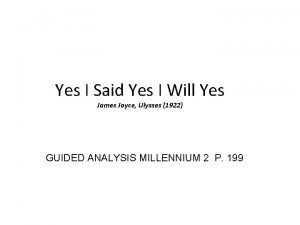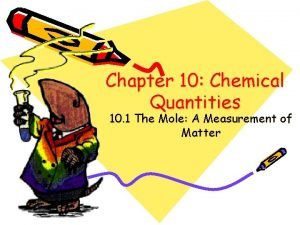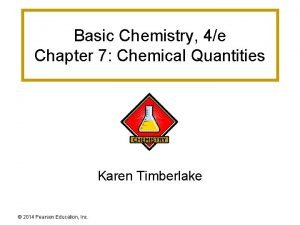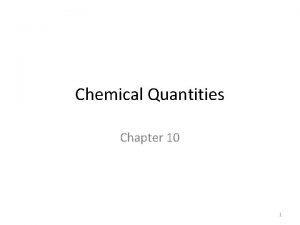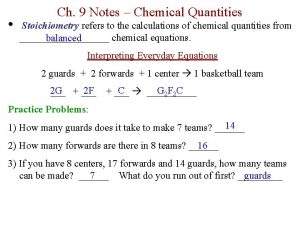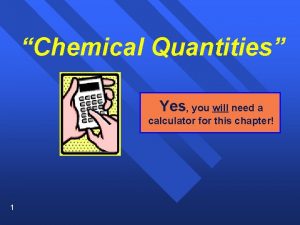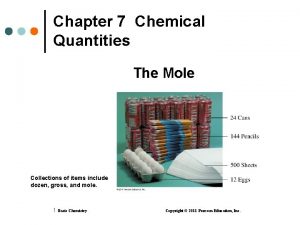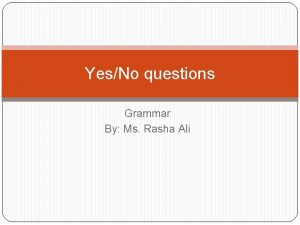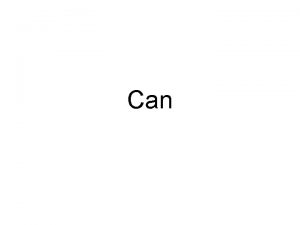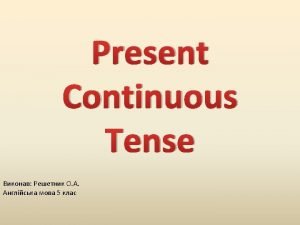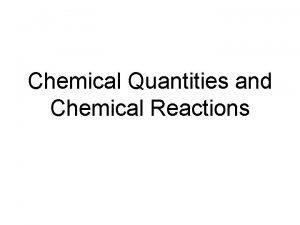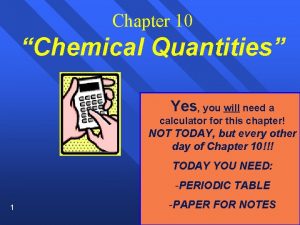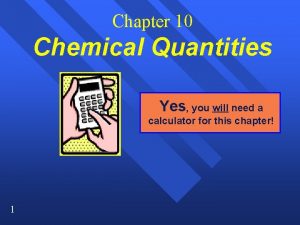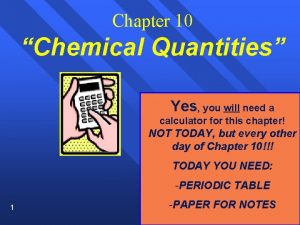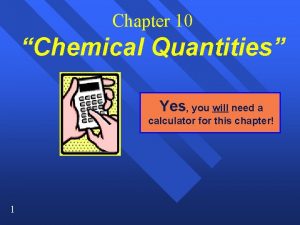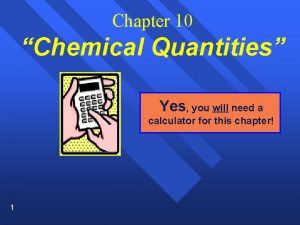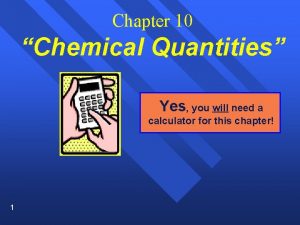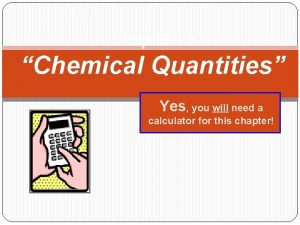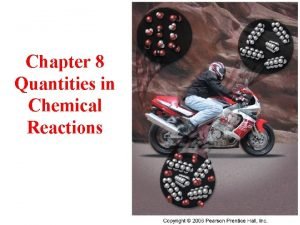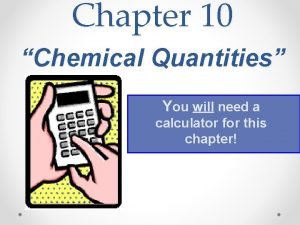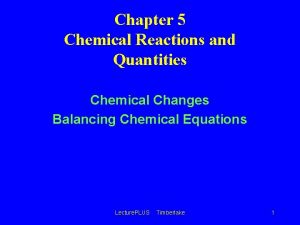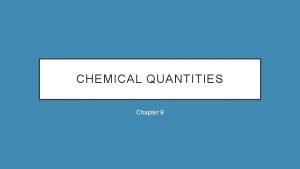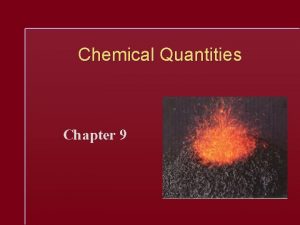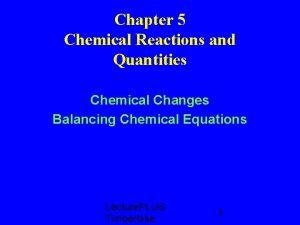Chapter 10 Chemical Quantities Yes you will need




































- Slides: 36

Chapter 10 “Chemical Quantities” Yes, you will need a calculator for this chapter!

Section 10. 1 The Mole: A Measurement of Matter • OBJECTIVES: • Describe methods of measuring the amount of something. • Define Avogadro’s number as it relates to a mole of a substance. • Distinguish between the atomic mass of an element and its molar mass. • Describe how the mass of a mole of a compound is calculated.

How do we measure items? §You can measure mass, §or volume, §or you can count pieces. §We measure mass in grams. §We measure volume in liters. §We count pieces in MOLES.

What is the mole? We’re not talking about this kind of mole!

Moles (is abbreviated: mol) §It is an amount, defined as the number of carbon atoms in exactly 12 grams of carbon-12. 23 § 1 mole = 6. 022 x 10 of the representative particles. §Treat it like a very large dozen § 6. 022 x 1023 is called: Avogadro’s number.

Similar Words for an amount §Pair: 1 pair of shoelaces = 2 shoelaces §Dozen: 1 dozen oranges = 12 oranges §Gross: 1 gross of pencils = 144 pencils §Ream: 1 ream of paper = 500 sheets of paper

What are Representative Particles? § The smallest pieces of a substance: 1) For a molecular compound: it is the molecule. 2) For an ionic compound: it is the formula unit (made of ions). 3) For an element: it is the atom. • Remember the 7 diatomic elements? (made of molecules)

Types of questions • How many oxygen atoms in the following? Ca. CO 3 3 atoms of oxygen Al 2(SO 4)3 12 (3 x 4) atoms of oxygen • How many ions in the following? Ca. Cl 2 3 total ions (1 Ca ion and 2 Cl ions) Na. OH 2 total ions (1 Na ion and 1 OH ion) Al 2(SO 4)3 2+ 1+ 1 - 1 - 5 total ions (2 Al 3+ + 3 SO 42 - ions)

Practice problems (round appropriately. ) §How many molecules of CO 2 are in 4. 56 moles of CO 2? 2. 75 x 10 molecules §How many moles of water is 5. 87 x 1022 molecules? 0. 0975 mol (or 9. 75 x 10 ) §How many atoms of carbon are in 1. 23 moles of C 6 H 12 O 6? 4. 44 x 10 atoms C 24 §How many moles is 7. 78 x 10 formula units of Mg. Cl 2? 24 -2 24 12. 9 moles

Measuring Moles §Remember relative atomic mass? - The amu was one twelfth the mass of a carbon-12 atom. §Since the mole is the number of atoms in 12 grams of carbon-12, §the decimal number on the periodic table is also the mass of 1 mole of those atoms in grams.

Gram Atomic Mass (gam) §Equals the mass of 1 mole of an element in grams (from periodic table) § 12. 01 grams of C has the same number of pieces as 1. 008 grams of H and 55. 85 grams of iron. §We can write this as: 12. 01 g C = 1 mole C (this is also the molar mass) §We can count things by weighing them.

Examples §How much would 2. 34 moles of carbon weigh? 28. 1 grams C §How many moles of magnesium is 24. 31 g of Mg? 1 mol Mg §How many atoms of lithium is 1. 00 g of Li? 8. 68 x 10 atoms Li §How much would 3. 45 x 1022 atoms of U weigh? 22 13. 6 grams U

What about compounds? §in 1 mole of H 2 O molecules there are two moles of H atoms and 1 mole of O atoms (think of a compound as a molar ratio) §To find the mass of one mole of a compound • determine the number of moles of the elements present • Multiply the number times their mass (from the periodic table) • add them up for the total mass

Calculating Formula Mass Calculate the formula mass of magnesium carbonate, Mg. CO 3 24. 3 g + 12 g + 3 x (16. 00 g) = 84. 3 g Thus, 84. 3 grams is the formula mass for Mg. CO 3.

Text Book Questions Page 291 #3, 4 Page 296 #7, 8, 13, 14, 15

Section 10. 2 Mole-Mass and Mole-Volume Relationships • OBJECTIVES: • Describe how to convert the mass of a substance to the number of moles of a substance, and moles to mass. • Identify the volume of a quantity of gas at STP.

Molar Mass §Molar mass is the generic term for the mass of one mole of any substance (expressed in grams/mol) §The same as: 1) Gram Molecular Mass (for molecules) 2) Gram Formula Mass (ionic compounds) 3) Gram Atomic Mass (for elements) • molar mass is just a much broader term than these other specific masses

Examples §Calculate the molar mass of the following and tell what type it is: Na 2 S = 78 g/mol gram formula mass N 2 O 4 = 92 g/mol gram molecular mass C = 12 g/mol gram atomic mass Ca(NO 3)2 = 164 g/mol gram formula mass C 6 H 12 O 6 (NH 4)3 PO 4 = 180 g/mol gram molecular mass = 149 g/mol gram formula mass

Since Molar Mass is… §The number of grams in 1 mole of atoms, ions, or molecules, §We can make conversion factors from these. - To change between grams of a compound and moles of a compound.

For example §How many moles is 5. 69 g of Na. OH?

Text Book Question Page 298 – 299 #16 – 19

The Mole-Volume Relationship § Many of the chemicals we deal with are in the physical state as: gases. - They are difficult to weigh (or mass). § But, we may still need to know how many moles of gas we have. § Two things effect the volume of a gas: a) Temperature and b) Pressure § We need to compare all gases at the same temperature and pressure.

Standard Temperature and Pressure § 0ºC and 1 atm pressure - is abbreviated “STP” § At STP, 1 mole of any gas occupies a volume of 22. 4 L - Called the molar volume § This is our fourth equality: 1 mole of any gas at STP = 22. 4 L

Practice Examples § What is the volume of 4. 59 mole of CO 2 gas at STP? = 103 L § How many moles is 5. 67 L of O 2 at STP? = 0. 253 mol § What is the volume of 8. 8 g of CH 4 gas at STP? = 12. 3 L

Density of a gas § D = m / V (density = mass/volume) - for a gas the units will be: g / L § We can determine the density of any gas at STP if we know its formula. § To find the density we need: 1) mass and 2) volume. § If you assume you have 1 mole, then the mass is the molar mass (from periodic table) § And, at STP the volume is 22. 4 L.

Practice Examples (D=m/V) § Find the density of CO 2 at STP. D = 44 g/22. 4 L = 1. 96 g/L § Find the density of CH 4 at STP. D = 16 g/22. 4 L = 0. 716 g/L

Another way: § If given the density, we can find the molar mass of the gas. § Again, pretend you have 1 mole at STP, so V = 22. 4 L. modify: D = m/V to show: § “m” will be the mass of 1 mole, since you have 22. 4 L of the stuff. § What is the molar mass of a gas with a density of 1. 964 g/L? = 44. 0 g/mol § How about a density of 2. 86 g/L? = 64. 0 g/mol

Summary • These four items are all equal: a) 1 mole b) molar mass (in grams/mol) c) 6. 022 x 1023 representative particles (atoms, molecules, or formula units) d) 22. 4 L of gas at STP Thus, we can make conversion factors from these 4 values!

Text Book Questions Page 301 #20, 21 Page 302 #22, 23 Page 303 #25 – 31

Section 10. 3 Percent Composition and Chemical Formulas • OBJECTIVES: • Describe how to calculate the percent by mass of an element in a compound. • Interpret an empirical formula. • Distinguish between empirical and molecular formulas.

Calculating Percent Composition of a Compound § Like all percent problems: part x 100 % = percent Whole 1) Find the mass of each of the components (the elements), 2) Next, divide by the total mass of the compound; then x 100

Example §Calculate the percent composition of a compound that is made of 29. 0 grams of Ag with 4. 30 grams of S.

Getting it from the formula §If we know the formula, assume you have 1 mole, §then you know the mass of the elements and the whole compound (these values come from the periodic table!).

Examples §Calculate the percent composition of C 2 H 4? 85. 7% C, 14. 3 % H §How about Aluminum carbonate? §Sample Problem 10. 10, p. 307 23. 1% Al, 15. 4% C, and 61. 5 % O §We can also use the percent as a conversion factor §Sample Problem page 308

Text Book Questions Page 306 – 307 #32 – 35

 Yes i said yes i will yes analisi
Yes i said yes i will yes analisi I m trading
I m trading Cloudcap piccolo
Cloudcap piccolo Linear acceleration and angular acceleration
Linear acceleration and angular acceleration Yes yes lord amen
Yes yes lord amen Label an atom
Label an atom Chemistry chapter 10 chemical quantities
Chemistry chapter 10 chemical quantities Chapter 7 chemical quantities answer key
Chapter 7 chemical quantities answer key Calculate it
Calculate it Chapter 10 chemical quantities practice problems answer key
Chapter 10 chemical quantities practice problems answer key Chapter 9 chemical quantities
Chapter 9 chemical quantities Stand still laddie
Stand still laddie The calculations of quantities in chemical reactions
The calculations of quantities in chemical reactions The calculation of quantities in chemical equations
The calculation of quantities in chemical equations Chemical quantities calculator
Chemical quantities calculator Unit chemical quantities the mole 1 step
Unit chemical quantities the mole 1 step We wish you strength
We wish you strength Punctuating split speech
Punctuating split speech Empirical formula pogil
Empirical formula pogil Modern chemistry chapter 7
Modern chemistry chapter 7 Are kc and kp equal
Are kc and kp equal Yesno question
Yesno question Do you like banana
Do you like banana Ilike broccoli
Ilike broccoli Do you speak english yes i do
Do you speak english yes i do Would you like banana or strawberries
Would you like banana or strawberries I am you are he is she is
I am you are he is she is Do you like bananas
Do you like bananas Do you like yes i do
Do you like yes i do Vector quantities measure
Vector quantities measure Chemical reactions section 2 classifying chemical reactions
Chemical reactions section 2 classifying chemical reactions Chemical reactions section 2 classifying chemical reactions
Chemical reactions section 2 classifying chemical reactions Chemical reactions section 1 chemical changes
Chemical reactions section 1 chemical changes Chapter 10 chemical reactions answer key
Chapter 10 chemical reactions answer key Chapter 9 chapter assessment chemical reactions
Chapter 9 chapter assessment chemical reactions Chemical names and formulas chapter 9
Chemical names and formulas chapter 9 You need a passport to cross the
You need a passport to cross the
